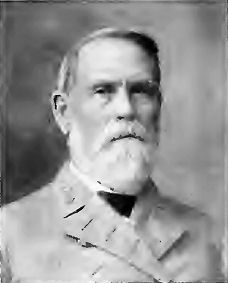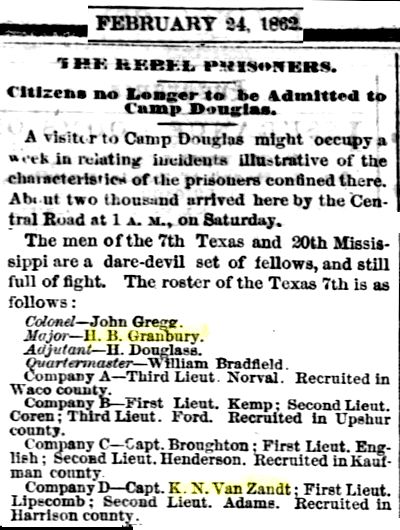Khleber Miller Van Zandt (1836-1930) cut a wide swath through Fort Worth civic affairs for sixty years.
 At age ninety-three Van Zandt wrote his autobiography, a self-effacing book entitled Force Without Fanfare. Among my favorite anecdotes in the book are two that relate to his experiences in the Civil War.
At age ninety-three Van Zandt wrote his autobiography, a self-effacing book entitled Force Without Fanfare. Among my favorite anecdotes in the book are two that relate to his experiences in the Civil War.

This is Van Zandt’s muster roll index card for the Confederate army. In 1861 he enlisted at Marshall, where he lived before moving to Fort Worth in 1865. He would reach the rank of major and afterward be known in civilian life in Fort Worth as “the Major.”
 During the week of February 11-16, 1862 then-Captain Van Zandt fought in the Confederacy’s 7th Texas Infantry at the Battle of Fort Donelson in Tennessee. (Kurz and Allison lithograph Battle of Fort Donelson from Wikipedia.)
During the week of February 11-16, 1862 then-Captain Van Zandt fought in the Confederacy’s 7th Texas Infantry at the Battle of Fort Donelson in Tennessee. (Kurz and Allison lithograph Battle of Fort Donelson from Wikipedia.)
 The 7th Texas Infantry fought under Brigadier General Gideon J. Pillow and Colonel John M. Simonton. (Diagram from Wikipedia.)
The 7th Texas Infantry fought under Brigadier General Gideon J. Pillow and Colonel John M. Simonton. (Diagram from Wikipedia.)
Van Zandt recalled a telling “quiet” moment during that horrific battle in which eight hundred would be killed:
“The fighting continued all day Sunday, September 20, and on until about nine o’clock that night. We made camp at a spot the Federals had been using for a field hospital. Their wounded and dead were all around us, and all night we could hear the groaning of the injured. Early next morning our men went foraging. Some went for water. Others went to see if there was any food to be found in the haversacks of the dead Yankees. Billy Rogers, one of my men, was in a mighty bad fix; but he found some coffee and made himself a cup of it. He was just putting it to his lips, when a wounded Ohio captain dragged himself up to our fire. Without a word, Billy handed the coffee to the Yankee, saying, ‘You are worse off than I.’ I think this instance, and many others, show that the men who did the fighting did not have any animosity toward each other.”
 The Battle of Fort Donelson was a Union victory. Van Zandt’s garrison surrendered. This report on the battle in the Edgefield, South Carolina, Advertiser lists the 7th Texas among the Confederate forces.
The Battle of Fort Donelson was a Union victory. Van Zandt’s garrison surrendered. This report on the battle in the Edgefield, South Carolina, Advertiser lists the 7th Texas among the Confederate forces.

Van Zandt was taken prisoner and held first at Camp Douglas, then Camp Chase, then Johnson’s Island. Note that Hiram Bronson Granbury was a major in the 7th Texas.
Later in 1862 Van Zandt was returned to duty through a prisoner exchange and fought on for the Confederacy, including at the Battle of Missionary Ridge in 1863. (Granbury also fought at Missionary Ridge. Thirty years later Van Zandt would be the temporary guardian of Granbury’s mortal remains.)
Years after the war, Van Zandt wrote, he and a man named “Walter Decker” became friends in Fort Worth, although Van Zandt did not know Decker’s background. One day, Van Zandt wrote, Decker came up to him and began shaking his hand. “I just learned you and I were in the army together,” Decker said with great excitement.
“What company did you belong to?” Van Zandt asked.
Decker answered with a question: “Were you the captain of the 7th Texas Regiment?”
“Yes.”
“Well, I was in the 7th Illinois.”
Thus, by “you and I were in the army together” Decker meant “you and I were in the same war but on different sides”!
The Confederacy’s 7th Texas and the Union’s 7th Illinois had fought each other at the Battle of Fort Donelson in 1862.
 Decker was wounded in the battle.
Decker was wounded in the battle.

This is Walter Decker’s listing on the 1890 census veterans schedule. Decker spent four years and seven months in the Union army.
Van Zandt recalled of his conversation with Decker: “In one battle at Fort Donelson, eight of their men and four of ours were killed, and there we were, two surviving members of opposing armies, the best of friends and as ready to stand up for one another as if we had fought side by side.”
In fact, Van Zandt wrote, some time later Decker was preparing to return to Illinois for a visit and asked Van Zandt to write him a letter of recommendation “saying I am a good citizen.”
Van Zandt readily consented but pointed out to Decker that no one in Illinois would know who the heck Van Zandt was.
Decker’s reply to his former “enemy” reminds us that, as wars go, the War Between the States was especially perverse—it was an uncivil war fought by innately civil people who otherwise were of the same “we, the people” and respected each other:
Decker told Van Zandt: “Write it [the letter of recommendation] to my old commander. I will tell him you belonged to the 7th Texas Regiment, and he will know who you are. Everybody there knows about and respects the 7th Texas.”
 These two survivors of an uncivil war lived long lives. Decker was eighty-four in 1930. The Major was ninety-three.
These two survivors of an uncivil war lived long lives. Decker was eighty-four in 1930. The Major was ninety-three.
Other posts about Van Zandt:
Van Zandt: Father and Son, State and City (Part 1)
From Adams’s Beaver Hat to Dylan’s Coffee Table
A Rock and a Lock: Old-Fashioned Customer Service at the Trinity River Bank
Hotel Block: From “Sad and Gloomy” to the Golden Goddess
Buttons and Bones: The Life, Death, and 3 Burials of 2 Confederate Generals






Sometime back I read here of a man and woman from AL pr GA who sent letters to one another, married and lived on Belknap or Weatherford. I enjoyed their letters written in “Old Man River” language. But I do not know where to find the article. Hope you can help me.
Doug
Doug, I have access to searchable Star-Telegram archives only up to 1992. In addition, those words—letters, Georgia, Alabama, Belknap, Weatherford—are so common that any combination of them as search keywords turns up hundreds of hits. I have not been able to find anything.